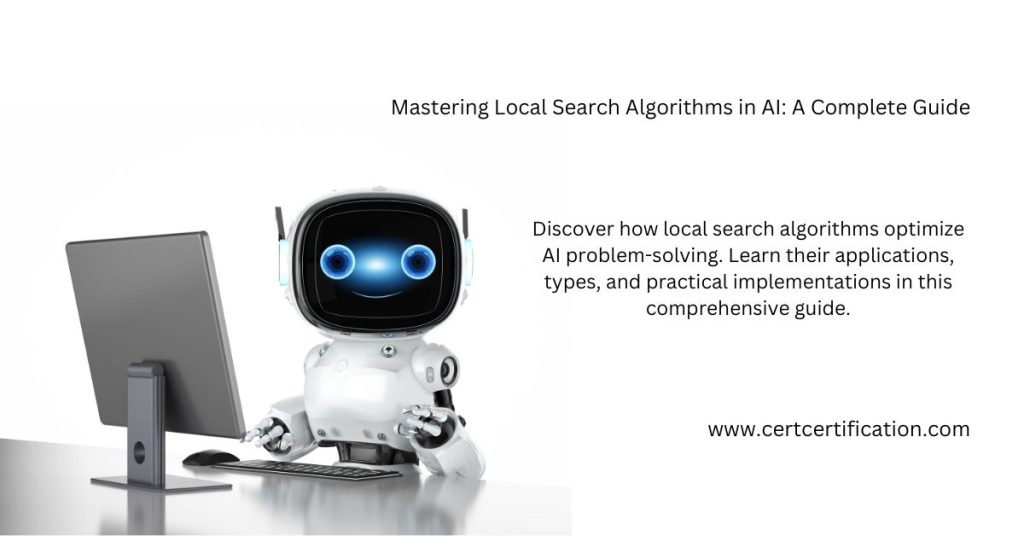
AI Local Search Algorithms: A Comprehensive Guide
Ever wondered how AI navigates complex problems? It's all thanks to the local search algorithm in artificial intelligence. This blog covers everything you need to know about this essential algorithm.
We'll explore how local search algorithms function, their applications across various domains, and their role in solving some of AI's toughest challenges.
What Is Local Search in AI?
A local search algorithm in AI is a versatile tool for efficiently tackling optimization problems. Often referred to as simulated annealing or hill-climbing, it uses greedy search techniques to find the best solution within a specific region. This approach is widely applicable across AI tasks, such as mapping locations or finding nearby restaurants.
Key Features of Local Search Algorithms
Exploration and Evaluation
The primary goal of local search is to find the optimal outcome by systematically exploring potential solutions and evaluating them against predefined criteria.
User-defined Criteria
Users can define specific objectives the algorithm must meet, such as finding the most efficient route between two points or the lowest-cost option for a particular item.
Efficiency and Versatility
Local search is popular for its ability to quickly identify optimal solutions from large datasets with minimal user input. Its versatility allows it to handle complex problem-solving scenarios efficiently.
In essence, local search in AI offers a robust solution for optimizing systems and solving complex problems, making it indispensable for developers and engineers.
How Local Search Algorithms Work
Initialization
The algorithm starts by initializing an initial solution or state, which can be randomly generated or chosen based on heuristic knowledge.
Evaluation
The current solution is evaluated using an objective function or fitness measure to quantify how well it meets the problem’s optimization goals.
Neighborhood Generation
The algorithm generates neighboring solutions from the current solution by applying minor modifications to explore nearby regions of the search space.
Neighbor Evaluation
Each generated neighboring solution is evaluated using the same objective function to calculate its fitness or quality.
Selection
The algorithm selects one or more neighboring solutions based on their evaluation scores, aiming to identify the most promising solutions.
Acceptance Criteria
The selected neighboring solution(s) are compared to the current solution based on acceptance criteria, determining whether a neighboring solution is accepted as the new current solution.
Update
If a neighboring solution meets the acceptance criteria, it replaces the current solution. Otherwise, the algorithm continues exploring additional neighboring solutions.
Termination
The algorithm repeats the process until a termination condition is met, such as reaching a maximum number of iterations or achieving a target solution quality.
Types of Local Search Algorithms
Hill Climbing
Starts with an arbitrary solution and makes minor changes to improve it, moving toward a peak until no further improvement is found.
Simulated Annealing
Inspired by the annealing process in metallurgy, this method allows occasional acceptance of worse solutions to escape local maxima and aim for a global maximum.
Genetic Algorithm
Inspired by natural selection, this method works with a population of solutions, applying crossover and mutation operators to evolve them over generations.
Local Beam Search
Keeps track of multiple states, generating all successors of the current states and selecting the best ones to continue.
Practical Applications
Hill Climbing: Job Shop Scheduling
Efficient job shop scheduling improves production efficiency in manufacturing, reduces downtime, and optimizes resource utilization.
Simulated Annealing: Network Design
Applying simulated annealing to network design results in more efficient and cost-effective network topologies, improving data transmission speeds and reliability.
Genetic Algorithm: Supply Chain Optimization
Utilizing genetic algorithms for supply chain optimization leads to lower operational costs, reduced delivery times, and improved customer satisfaction.
Local Beam Search: Robot Path Planning
Optimizing robot paths improves navigation efficiency, reducing travel time and energy consumption.
Choosing the Right Optimization Type
Selecting the proper optimization method is crucial for efficiently achieving optimal solutions, navigating problem constraints, ensuring robust performance, and maximizing resource utilization.
Learn More
Master local search algorithms for AI effortlessly with Great Learning’s comprehensive courses. Whether you're delving into Hill Climbing or exploring Genetic Algorithms, our structured approach makes learning intuitive and enjoyable. Enroll now to be part of this high-demand field.
Conclusion
This guide covers everything you need to know about local search algorithms for AI. For deeper insights and the most demanded skills, consider enrolling in Great Learning’s Post Graduate Program in Artificial Intelligence & Machine Learning.
FAQs
How do local search algorithms compare to global optimization methods?
Local search algorithms focus on finding optimal solutions within a local region, while global optimization methods aim to find the best solution across the entire search space.
How can local search algorithms be adapted for real-time decision-making?
Techniques such as online learning and adaptive neighborhood selection can help adapt local search algorithms for real-time decision-making.
Are there any open-source libraries for implementing local search algorithms?
Yes, several open-source libraries like Scikit-optimize, Optuna, and DEAP offer implementations of various local search algorithms.
Comments (0)